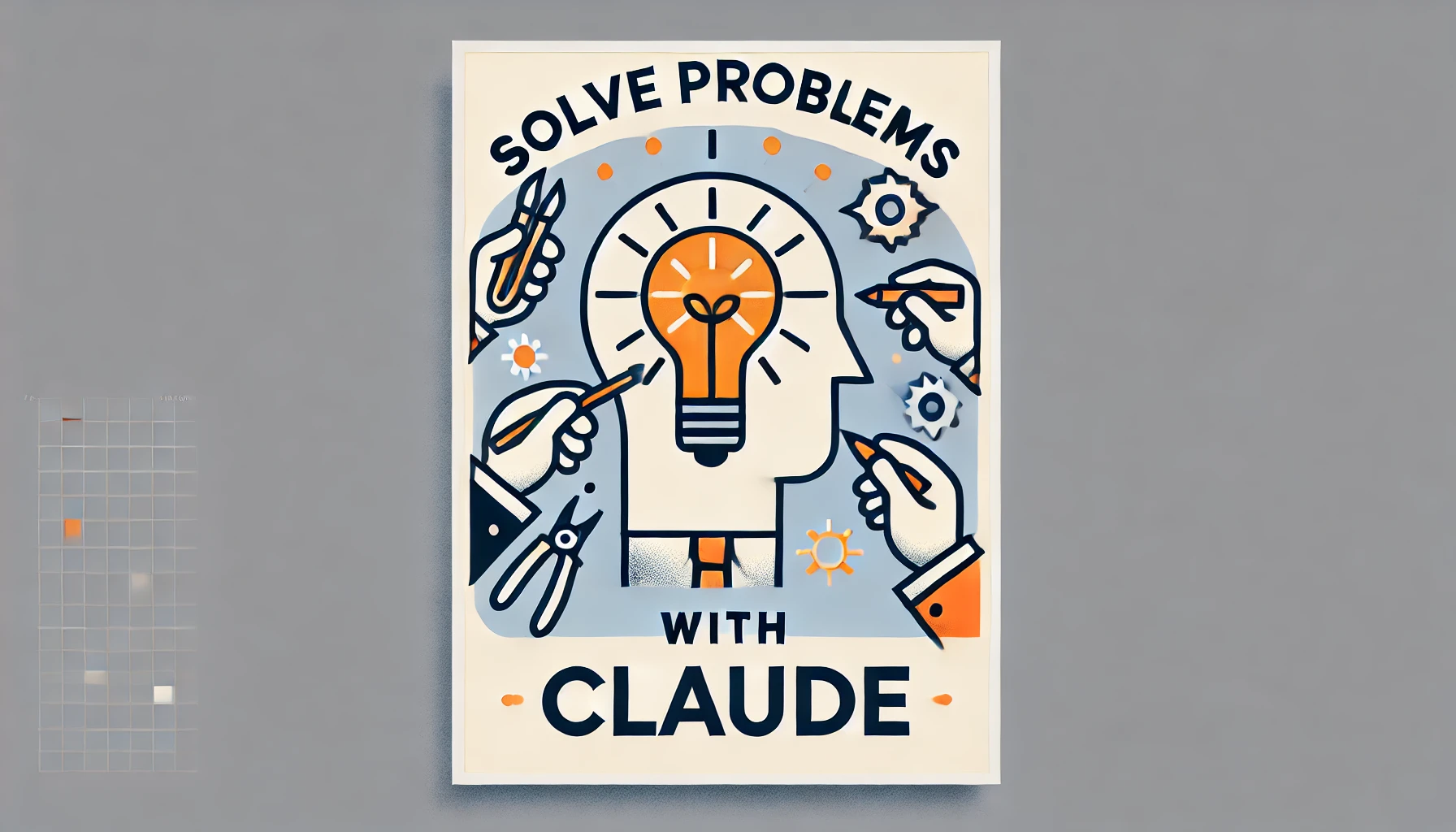
LLM
27 Jul 2024
Read 24 min
Mastering Problem Solving with Claude Sonnet 3.5: Your Guide to Efficient Solutions
Unlock efficient solutions with Claude Sonnet 3.5. Ready to master problem solving?
Claude Sonnet 3.5: Your Comprehensive Guide to Effective Problem Solving
When it comes to solving problems, Claude Sonnet 3.5 from Anthropic is a top-tier choice. This advanced AI tool not only helps you identify problems but also guides you step-by-step toward a solution. What strategy should you follow to fully leverage the potential of Claude Sonnet 3.5? In this article, we provide a detailed guide on problem solving with Claude Sonnet 3.5 and show you how to proceed effectively and efficiently.
“Claude Sonnet 3.5 is not just a tool but an intelligent companion in problem solving.”
- Identifying problems with Claude Sonnet 3.5
- Step-by-step guidance to solution finding
- Effective utilization of AI-assisted features
These three core areas form the foundation for a successful problem-solving strategy. Read on to learn how to master each of these steps with ease.
Introduction: Why Claude Sonnet 3.5?

Claude Sonnet 3.5 is a powerful tool designed specifically to solve complex problems effectively and efficiently. In an increasingly complex world where quick and precise decisions are of paramount importance, this system offers a robust solution based on cutting-edge technology. User-friendliness, flexibility, and intelligent algorithms are just a few reasons why Claude Sonnet 3.5 is the preferred instrument for many professionals.
By integrating advanced methods like big data analysis, machine learning, and artificial intelligence, Claude Sonnet 3.5 delivers not only precise but also actionable insights. This makes it easier to make informed decisions based on solid data rather than mere assumptions. Specific features, such as interactive dashboards and custom reports, help reduce data complexity and make relevant information quickly accessible.
Another highlight of Claude Sonnet 3.5 is its seamless integration into existing workflows and systems. With comprehensive compatibility, users can easily merge and analyze data from various sources. This leads to significant time savings and boosts overall productivity. Additionally, the security protocols are stringent, ensuring all data is handled securely and confidentially.
For companies operating in a competitive market, the ability to solve problems quickly and accurately often makes the difference between success and failure. That’s why Claude Sonnet 3.5 is the ideal choice. It not only supports you in identifying and analyzing problems but also in developing and implementing solutions aimed at long-term success.
The Basics of Problem Solving with Claude Sonnet 3.5
Understanding the fundamentals of problem solving with Claude Sonnet 3.5 is essential for leveraging its full potential. Whether you are dealing with simple or complex issues, mastering these basics will set you on the path to effective solutions.
Claude Sonnet 3.5 presents an advanced platform specifically designed for tackling complex problem-solving scenarios. Employing cutting-edge algorithms and artificial intelligence, this software facilitates intuitive solutions across diverse challenges. Users can rely on Claude Sonnet 3.5 not only for problem identification and analysis but also for generating and evaluating innovative solutions.
A crucial aspect of problem-solving with Claude Sonnet 3.5 is its systematic and structured approach. Initially, users should familiarize themselves with the user interface, which is clear and organized. The dashboard provides a quick overview of all relevant functions and tools.
Data Integration and Interfaces: Claude Sonnet 3.5 allows seamless integration of various data sources. This is particularly useful for examining the problem from multiple perspectives and conducting a thorough analysis. The software supports different file formats and databases, enhancing flexibility and adaptability.
Algorithmic Support: The platform leverages advanced algorithms to identify patterns and relationships within the data. This automated analysis helps promptly recognize problem causes and suggests potential solution paths. The algorithms are designed to continuously learn and adapt, leading to increasingly precise results.
Ease of Use and Customizability: Despite the complexity of the underlying technology, Claude Sonnet 3.5 emphasizes user-friendliness. The software offers numerous customization options, enabling users to tailor the interface and functionalities to their specific needs. This significantly improves the efficiency and effectiveness of problem-solving processes.
In summary, Claude Sonnet 3.5 provides all the necessary tools and techniques for methodically and efficiently solving complex problems. The combination of data integration, algorithmic support, and user-friendliness makes the software a powerful partner in the problem-solving process.
First Steps: Problem Identification & Target Definition

The first step toward effective problem-solving with Claude Sonnet 3.5 involves precise problem identification. It is essential to articulate the problem clearly to avoid any ambiguities. A straightforward question such as “What exactly is the problem?” can be highly beneficial. Claude Sonnet 3.5, with its powerful AI, aids in structuring data and information efficiently to help understand the problem in its entirety.
Following a clear problem identification, the next step is goal setting. Here, it is crucial to establish clear, measurable objectives. Claude Sonnet 3.5 offers tools that assist in formulating specific and realistic goals. A well-defined goal includes the following elements:
- Specific: The goal must be clearly and precisely described.
- Measurable: Progress and success must be quantifiable.
- Achievable: The goal should be realistic and attainable.
- Relevant: It should be significant and crucial to problem-solving.
- Time-bound: A clear timeframe for achieving the goal is essential.
This structured approach ensures clarity of the expected outcomes from the beginning. Through its project planning and goal-tracking features, Claude Sonnet 3.5 significantly contributes to making this initial phase efficient and focused. This lays a solid foundation for all subsequent steps in the problem-solving strategy.
Analysis Phase: Collecting Data & Information
Once the problem is clearly defined, the analysis phase begins. This stage emphasizes the collection of relevant data and information to make an informed decision. Claude Sonnet 3.5 supports this process with its advanced data analysis and processing tools.
A crucial step in this phase is identifying and capturing all pertinent information. This includes both quantitative data, such as numerical measurements and statistics, and qualitative data, like expert opinions and case studies. Claude Sonnet 3.5 offers specialized interfaces that allow seamless integration of data from various sources like databases, APIs, and documents.
- Data Integration: Claude Sonnet 3.5 aggregates and consolidates data from diverse sources, facilitating the creation of a comprehensive and unified data pool.
- Data Preparation: The software incorporates features for cleaning and normalizing data to ensure that all information is accurate and compatible.
- Data Analysis: With powerful analytical tools, Claude Sonnet 3.5 enables the identification of patterns and trends that might otherwise be overlooked.
Following the collection of relevant data, a thorough analysis is conducted. This analysis aims to gain deeper insights into the problem and identify its underlying causes. Claude Sonnet 3.5 uses advanced algorithms for data processing and offers visualization tools to present complex datasets clearly. Charts, graphs, and interactive dashboards help structure information and make it more interpretable.
An essential technique in this phase is the Means-End Analysis, which involves identifying end goals and breaking them down into achievable sub-goals. Claude Sonnet 3.5 provides tools to implement this technique by enabling the definition of goals and associated actions and tracking their progress. This fosters a systematic approach that increases the likelihood of a successful problem resolution.
With Claude Sonnet 3.5’s comprehensive analytical capabilities, all relevant aspects of the problem can be illuminated. The collected and analyzed data form the foundation for the subsequent phases of the problem-solving process, particularly the creative idea development and the subsequent evaluation of proposed solutions.
Creative Idea Development with Claude Sonnet 3.5

The creative idea development phase is crucial for solving complex problems. With Claude Sonnet 3.5, several innovative approaches are employed to generate a wide range of solution possibilities.
1. Brainstorming: Claude Sonnet 3.5 leverages advanced algorithms to enhance the efficiency of brainstorming sessions. The software allows you to collect a substantial number of ideas quickly, automatically categorizing and evaluating them.
2. Utilizing AI-Powered Suggestions: By harnessing artificial intelligence, Claude Sonnet 3.5 analyzes existing data and past problem-solving efforts to generate relevant suggestions that might otherwise be overlooked. This capability fosters creative thinking and helps discover innovative solutions.
3. Scenario-Based Planning: Another strength of Claude Sonnet 3.5 is its ability to simulate various scenarios and evaluate their potential outcomes. This practical testing of different approaches allows you to prioritize the best ideas.
4. Encouraging Collaboration: Claude Sonnet 3.5 enhances collaborative idea development through integrated communication and collaboration tools. These tools enable teams to work together in real-time, exchange ideas, and provide feedback effectively.
5. Visual Aids: The software also offers a variety of visual aids such as mind maps and diagrams, which help structure complex ideas and make them more comprehensible. These visualizations simplify recognizing connections between different concepts and discovering new creative solutions.
Through these comprehensive features, Claude Sonnet 3.5 supports the entire creative idea development process, ensuring no valuable insights are lost. The software thus becomes an indispensable tool for efficient and effective problem-solving.
Evaluation & Selection of the Best Proposed Solutions
After generating creative solutions, your next step is to evaluate and select the best options. Claude Sonnet 3.5 provides an array of tools to ensure this decision-making process is efficient and well-informed.
1. Define Criteria: To evaluate the best proposals, you need to set clear criteria. These might include cost, feasibility, time requirements, and potential risks. Claude Sonnet 3.5 allows you to structure and prioritize these criteria effectively.
2. Analyze Alternatives: Using Claude Sonnet 3.5, you can perform detailed analyses of the various solution approaches. The software helps visualize complex data and simulate potential impacts of each alternative. This facilitates making data-driven, informed decisions.
3. Decision Making: Claude Sonnet 3.5 integrates the decision matrix method, where you weight the established criteria and evaluate the solutions accordingly. This systematic approach enhances transparency and accountability in your decision-making process.
4. Acceptance and Feasibility: Beyond technical factors, it is crucial to consider whether a solution will be accepted by all stakeholders and if its implementation is realistic. Claude Sonnet 3.5 enables you to incorporate these social aspects into your evaluation, ensuring sustainable and feasible solutions.
By using these structured and analytical approaches, users of Claude Sonnet 3.5 can ensure that the selected solutions are not only efficient and effective but also practical to implement and widely accepted.
Realisation: From Planning to Action

The implementation of the chosen solution is a crucial step towards successful problem solving with Claude Sonnet 3.5. Once a solution is selected, detailed action planning begins. This process involves several key steps:
- Create a Solution Plan: A comprehensive solution plan considers all relevant aspects, such as resources, timelines, involved personnel, and potential obstacles. Claude Sonnet 3.5 provides user-friendly tools for creating Gantt charts and other planning tools, offering a visualized roadmap of actions.
- Assign Tasks: Break down the chosen solution into smaller, actionable steps and assign these tasks to responsible team members. Clear roles and responsibilities are essential for smooth execution. The collaboration features of Claude Sonnet 3.5 greatly facilitate communication and coordination within the team.
- Allocate Resources: Ensure that all necessary resources – including human, material, and financial – are provided and optimally utilized. The software enables efficient resource management, helping to avoid bottlenecks.
- Develop a Communication Plan: Clear and continuous communication is crucial for successful implementation. Define communication channels and methods to regularly inform all stakeholders and enable feedback. This is where Claude Sonnet 3.5 excels, as it integrates various communication platforms, ensuring ongoing dialogue.
During the implementation phase, flexibility and adaptability are essential. Despite detailed planning, unexpected challenges may arise. It is important to regularly monitor progress and make adjustments as necessary. Claude Sonnet 3.5 offers real-time analytics tools to help track project status and proactively address deviations.
In conclusion, successful implementation of a solution requires not only a well-crafted plan but also clear communication, collaboration, and adaptability. Claude Sonnet 3.5 supports all these tasks, making the transition from planning to action efficient and transparent.
Correct Prompting when Solving Problems with Claude Sonnet 3.5
One of the key components for effective problem solving with Claude Sonnet 3.5 lies in correct prompting. Providing precise and clear instructions is crucial for obtaining optimal results from the AI. Here are some tips on how to shape this process:
1. Ask Clear and Precise Questions: Ensure that your questions and tasks are formulated in a way that Claude can easily understand. Avoid vague or ambiguous language.
2. Provide Context: Supply the AI with sufficient background information. The more context Claude has, the more accurate and relevant the responses will be.
3. Make Incremental Adjustments: If the initial answers are unsatisfactory, adjust your prompts incrementally. Small changes can help improve the accuracy and usefulness of the responses.
4. Iterative Feedback: Use Claude’s responses to continuously refine your problem-solving approach. Provide feedback on which aspects of the answers were helpful and which need further development.
By employing targeted and thoughtful prompting, you can maximize the effectiveness of Claude Sonnet 3.5 in your problem-solving process. Utilize this strategy to achieve faster and more precise results.
Success Monitoring & Adjustments
Once the solution has been implemented, it is crucial to systematically monitor and evaluate the achieved results. Claude Sonnet 3.5 offers a comprehensive suite of analytical tools to help you track your problem-solving initiatives in real-time.
Continuous Monitoring: Utilize the integrated dashboard features of Claude Sonnet 3.5 to consistently review key performance indicators (KPIs). These dashboards provide visual representations of current status reports, allowing for the swift identification of any discrepancies.
Regularly assess feedback and performance metrics to ensure that the implemented solutions are operating as intended. Establish feedback channels to enable stakeholders to continuously provide input and address unexpected developments promptly.
Adjustments and Optimizations: If the data reveals deviations or undesirable outcomes during monitoring, Claude Sonnet 3.5 offers flexible adjustment options. Modify existing plans and processes based on the collected information.
Engage in collaborative reviews to determine which aspects of your strategy need optimization. This can be achieved through repeated testing and experimentation based on analytical findings. The adaptive learning capability of Claude Sonnet 3.5 assists in iteratively improving solutions and scaling only viable approaches.
In summary, success monitoring and adjustments should be viewed as a cyclical process, with monitoring and feedback loops being integral components. By employing this methodical approach with Claude Sonnet 3.5, you maximize the likelihood of achieving sustainable and effective problem-solving outcomes.
Avoid Common Mistakes: Tips & Tricks
When leveraging Claude Sonnet 3.5 for problem-solving, it’s crucial to steer clear of common pitfalls. Here are some practical tips and tricks to enhance your efficiency and success:
- Define the Problem Clearly: Avoid jumping into solution mode without a thorough understanding of the problem. Take your time to define the issue in detail, and consider methods like the “5-Why” technique to uncover the root cause.
- Avoid Hasty Conclusions: It’s important to explore various approaches rather than rushing to implement a solution that may only address symptoms rather than the underlying cause.
- Experiment with Diverse Approaches: Trial and error can be effective, especially when multiple solutions are available. Utilize Claude Sonnet 3.5’s capabilities to test different hypotheses.
- Leverage Team Collaboration and Collective Knowledge: Tap into the power of teamwork and the diverse perspectives your colleagues bring. Claude Sonnet 3.5 supports the integration and evaluation of varied opinions and expertise.
- Stay Adaptable: Problems sometimes require creative and flexible approaches. Be prepared to adjust your strategy when new information or obstacles arise.
- Continuous Success Monitoring: Implement mechanisms for ongoing progress and effectiveness evaluation. Regular monitoring helps you take corrective actions early and adjust your approach as needed.
With Claude Sonnet 3.5, you have a powerful tool at your disposal that aids not only in problem-solving but also in avoiding these common mistakes. By following a structured approach and utilizing the tool’s advanced features, you significantly increase your chances of developing sustainable and effective solutions.
Case Studies: Successful Problem Solving with Claude Sonnet 3.5
Unfortunately, we are not allowed to publish the names of our customers.
A real-world example demonstrating the effectiveness of Claude Sonnet 3.5 can be found in the IT sector, where a large company faced the challenge of conducting a comprehensive data migration. The problem encompassed both technical and organizational dimensions, requiring meticulous planning and execution.
Case Study 1: The Comprehensive Data Migration
The company leveraged Claude Sonnet 3.5 to perform a detailed problem analysis. By utilizing the integrated analysis tools, relevant datasets were identified and migration paths established. The software assisted in early detection of potential risks and in planning appropriate countermeasures.
- Problem Identification: Claude Sonnet 3.5 facilitated a complete inventory of the existing data infrastructure, enabling the identification of inconsistent datasets and outdated information.
- Target Definition: Based on insights from the analysis phase, clear migration goals encompassing both qualitative and quantitative aspects were set.
- Idea Development: The software offered creative solutions through predefined migration plans and simulations of various scenarios, allowing the team to select the most feasible strategies.
- Implementation: The step-by-step execution was monitored continuously by Claude Sonnet 3.5, utilizing real-time data to track progress and allow for immediate adjustments when needed.
By the end of the migration, the company had successfully transferred its data to the new environment and significantly improved the efficiency of its processes. Thanks to Claude Sonnet 3.5, the transition was nearly seamless, with potential disruptions addressed promptly.
Case Study 2: Optimization of the Production Line in a Manufacturing Company
Another compelling example involves a manufacturing company that sought to optimize its production processes. Using Claude Sonnet 3.5, the company initially analyzed all existing production workflows to identify bottlenecks and inefficiencies.
“Claude Sonnet 3.5 helped us make our production line more efficient by providing detailed insights into problematic areas we previously overlooked.” — Production Manager
By systematically identifying problems and defining precise goals, specific measures for process improvement were developed. Creative ideas generated and tested by Claude Sonnet 3.5 led to the implementation of the most promising solutions. This thorough analysis resulted in a significant reduction in production times and costs.
These case studies clearly illustrate how Claude Sonnet 3.5 serves as a powerful tool for problem-solving across various industry sectors. Its versatile capabilities provide tailored solutions that enhance both efficiency and success.
Conclusion: Effective Problem Solving with Claude Sonnet 3.5
Claude Sonnet 3.5 proves to be a powerful tool for problem solving, distinguished by its diverse functionalities and intuitive interface. This step-by-step approach to problem resolution, ranging from problem definition to implementation and success monitoring, is significantly streamlined by the intelligent assistance of Claude Sonnet 3.5.
Notably, the tool excels in integrating structured and creative approaches. Users can conduct in-depth data analyses while simultaneously generating innovative solution ideas. The incorporation of advanced algorithms ensures that decisions are made on a solid foundation, while the user-friendly interface simplifies access to these features.
Another key advantage of Claude Sonnet 3.5 is its adaptability to various problem types and industries. Whether dealing with technical challenges, business decisions, or creative projects, the tool provides the necessary resources to develop informed and efficient solutions. Additionally, the built-in success monitoring allows for continuous adjustment and optimization of implemented measures.
In summary, Claude Sonnet 3.5 stands as a valuable resource for anyone facing complex problems. The tool not only aids in structuring and analyzing issues but also promotes creative problem-solving and the execution of well-thought-out actions. For those in search of a comprehensive and user-friendly solution for tackling challenges, Claude Sonnet 3.5 is an excellent choice.
FAQ
What are the main advantages of Claude Sonnet 3.5 in problem solving?
Claude Sonnet 3.5 offers a wide range of advantages, including an intuitive user interface, advanced algorithms for data analysis, and creative tools for idea generation. These features facilitate the quick identification and resolution of complex challenges.
How secure is my data when using Claude Sonnet 3.5?
Your data security is a top priority. Claude Sonnet 3.5 employs state-of-the-art encryption technologies and complies with the latest data protection regulations, ensuring your information is always safeguarded.
Can Claude Sonnet 3.5 be integrated into existing enterprise systems?
Yes, Claude Sonnet 3.5 is designed for flexibility and seamless integration with existing software and IT infrastructures, streamlining workflows and ensuring smooth implementation within your organization.
Does Claude Sonnet 3.5 offer support and training?
To ensure users harness the full potential of Claude Sonnet 3.5, comprehensive training and continuous support are provided. This includes webinars, tutorials, and personalized consultations with experts.
How quickly can results be achieved with Claude Sonnet 3.5?
Thanks to its user-friendly interface and powerful tools, tangible results can be achieved with Claude Sonnet 3.5 often within a few hours of intensive use.
What are the costs associated with using Claude Sonnet 3.5?
Claude Sonnet 3.5 offers various pricing models tailored to the needs of different business sizes and types. Detailed pricing information is available on the official pricing page.
Is Claude Sonnet 3.5 suitable for small businesses?
Absolutely. Claude Sonnet 3.5 is scalable and provides solutions for both small businesses and large enterprises. Its flexible features and modules can be customized to meet specific requirements.
Contents






